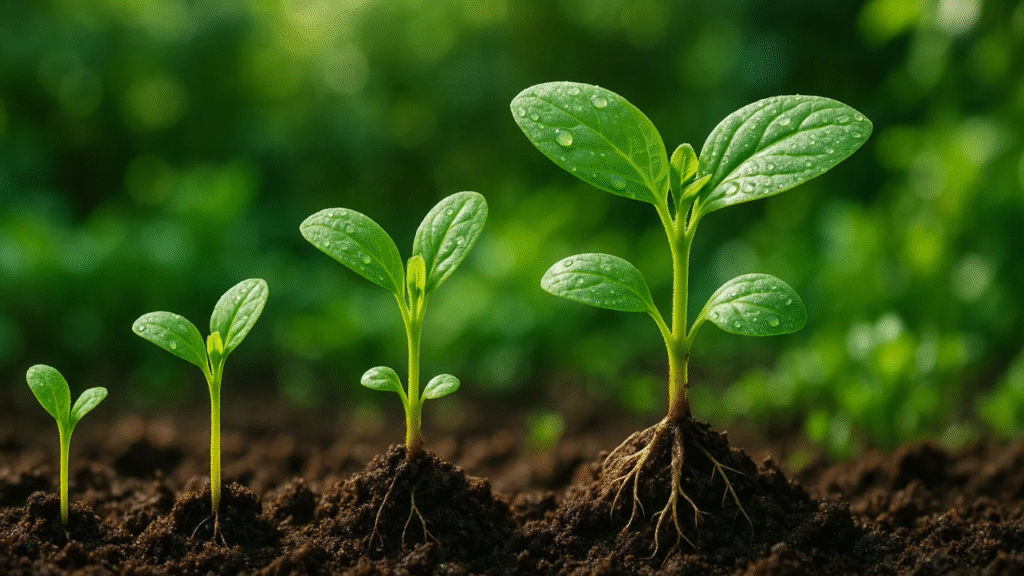
Moisture Control for Seedlings: Tips for Ensuring Healthy Growth and Strong Roots
When it comes to growing healthy seedlings, moisture control is key. Moisture control for seedlings ensures that young plants receive just the right amount of water—enough to support their growth, but not too much to cause root rot or stress. Too little moisture can stunt their development, while too much can drown them. In this guide, we’ll explore the importance of maintaining optimal moisture levels for seedlings and share practical tips on how to manage watering effectively. Whether you’re starting seeds indoors or transplanting them outside, mastering moisture control is crucial for giving your seedlings the best start in life. 🌸
Table of Contents
Toggle🌱 Why Moisture Control is Crucial for Seedling Health 🌱
Moisture control is a key factor in ensuring healthy seedling growth. Too much or too little water can stress young plants, leading to stunted growth, poor root development, or even plant death. Seedlings have delicate roots that are more susceptible to damage from inconsistent watering. 💧
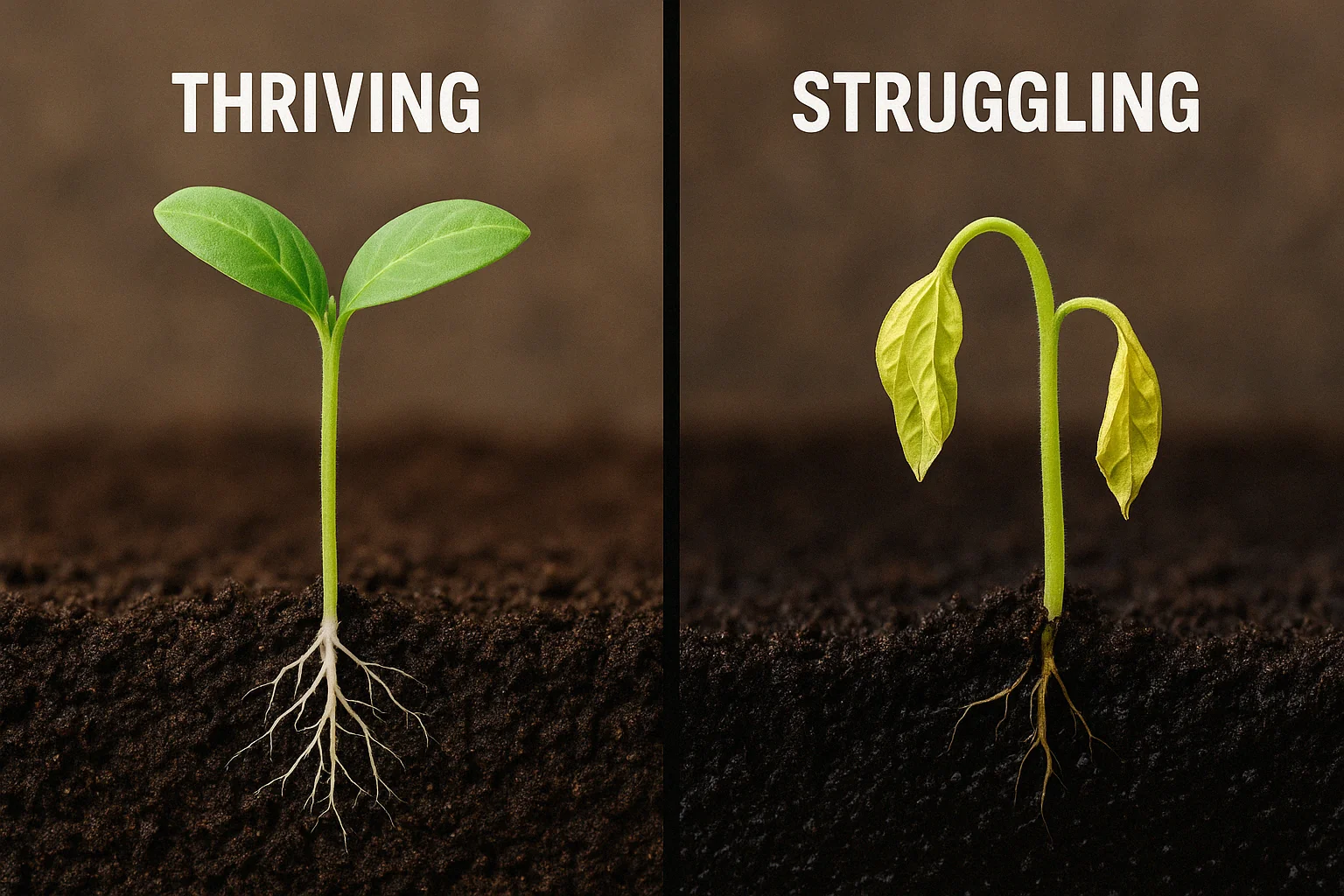
🚫 Prevents Overwatering 🚫
Overwatering is a common issue that can drown seedlings, causing root rot. Proper moisture control ensures that seedlings receive just the right amount of water, allowing the roots to absorb nutrients effectively without suffocating them. 💦
🌱 Supports Root Development 🌱
Seedlings need moisture for their roots to develop properly. Consistent watering promotes strong, deep root systems that are essential for healthy plants as they mature. 🌿
🌟 Encourages Even Growth 🌟
When seedlings receive steady moisture, they grow evenly and steadily. This leads to stronger plants that are more resistant to diseases and environmental stressors. 🌻
🍃 Enhances Nutrient Absorption 🍃
Moisture in the soil helps dissolve essential nutrients, making them available for seedlings. Without proper moisture, seedlings may struggle to absorb the nutrients they need to thrive. 🌾
By maintaining proper moisture levels, you set the foundation for strong, healthy seedlings that can grow into vibrant, robust plants. 🌼
💧 Understanding Seedling Watering Needs 💧
Watering seedlings properly is crucial for their growth and development. Too much or too little water can stress young plants, affecting their ability to thrive. Here’s a clear approach to ensure your seedlings get the right amount of hydration: 🌸

🌿 Consistent Moisture 🌿
Seedlings need consistently moist soil, but not soaking wet. The key is to keep the soil damp, not waterlogged. Over-watering can lead to root rot, while under-watering can stunt growth. 🌾
⏰ Watering Frequency ⏰
Water seedlings when the top inch of soil feels dry to the touch. During hot, dry weather, this may mean watering every day or every other day. However, during cooler periods, watering may only be needed once a week. 🌞
🚿 Watering Technique 🚿
Use a gentle watering can or a spray bottle to avoid disturbing the delicate seedlings. Water at the base of the plant, not from above, to prevent the foliage from getting soggy, which can encourage disease. 💧
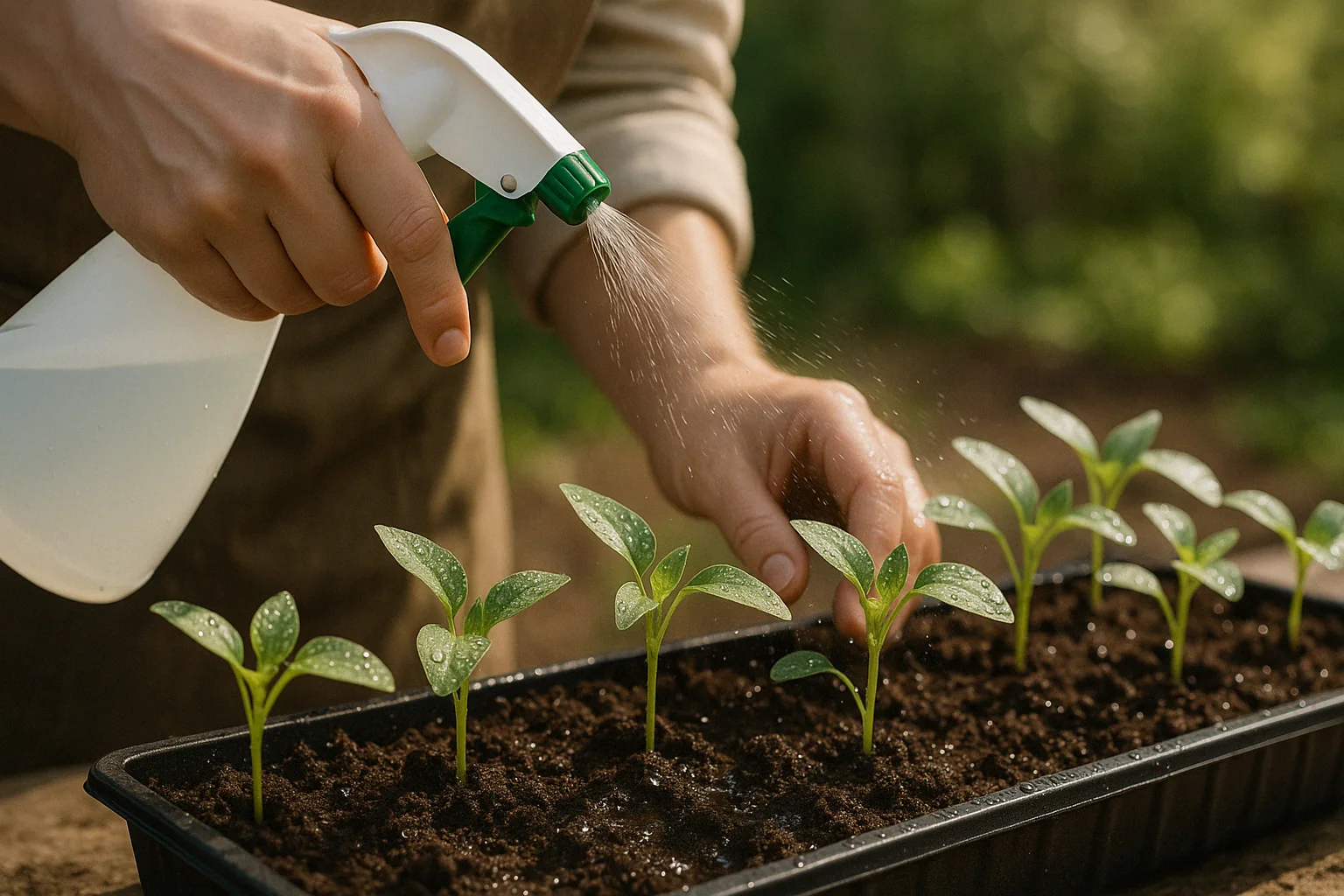
🌬️ Proper Drainage 🌬️
Ensure your seedling pots have good drainage. Stagnant water at the bottom of containers can cause the roots to suffocate. Always check that excess water can escape freely. 🌱
🌅 Time of Day 🌅
Water in the morning when possible. This gives the seedlings time to absorb moisture before the heat of the day, reducing the risk of fungal diseases that thrive in damp conditions. 🌞
By understanding these watering needs, you’ll give your seedlings the best chance to grow into healthy, strong plants. Keep it consistent and gentle, and your plants will thank you with robust growth. 🌻
🌿 Techniques for Effective Moisture Control 🌿
Effective moisture control is crucial for healthy plant growth, ensuring your plants receive just the right amount of water without being over- or underwatered. Here are some key techniques to maintain optimal moisture levels in your garden or home:

1. 🌾 Use Mulch to Retain Moisture 🌾
Mulch is one of the simplest and most effective ways to control moisture. Apply a layer of organic mulch (such as wood chips, straw, or grass clippings) around your plants. This helps to retain moisture in the soil, reduces evaporation, and keeps the soil temperature stable.
2. 🌱 Choose the Right Soil 🌱
Soil quality directly affects moisture retention. Loamy soil, which has a good balance of sand, silt, and clay, holds moisture well while draining excess water. If your soil drains too quickly, amend it with compost or organic matter to improve its ability to retain water.
3. 💧 Water Deeply, But Infrequently 💧
Watering deeply encourages plants to develop deep root systems that are better at accessing moisture. Rather than shallow, frequent watering, aim for deeper watering sessions every few days. This helps prevent the roots from becoming dependent on surface water and encourages healthier, stronger plants.
4. 🚿 Use Drip Irrigation Systems 🚿
Drip irrigation systems are an excellent way to control moisture efficiently. They deliver water directly to the base of each plant, reducing water waste and ensuring consistent moisture levels. Drip systems also prevent excess moisture from reaching the plant leaves, which can lead to disease.
5. 🌵 Choose Drought-Tolerant Plants 🌵
If you’re struggling with moisture control, consider choosing drought-tolerant plants. These plants are designed to thrive with minimal water, making them ideal for areas with inconsistent rainfall or dry spells.
By following these moisture control techniques, you can create an environment where your plants can flourish, thriving without the risk of dehydration or waterlogging. 🌸
🌊 Identifying and Correcting Moisture Problems 🌊
Proper moisture levels are crucial for the health of your plants. Both overwatering and underwatering can lead to a variety of issues. Here’s how to identify and correct moisture problems effectively:
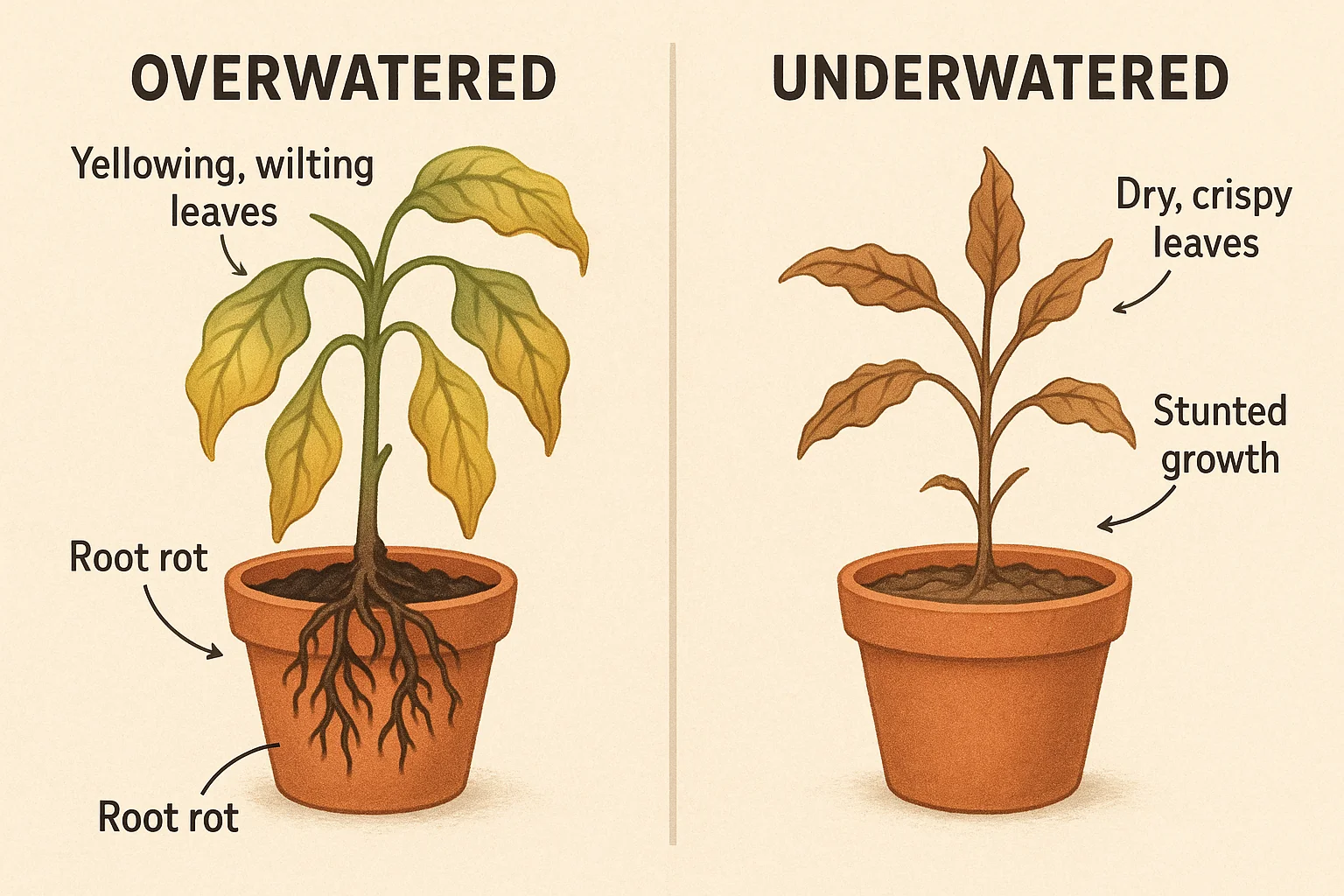
1. 🚫 Signs of Overwatering 🚫
- Yellowing Leaves: When your plant gets too much water, its roots can suffocate, leading to yellowing leaves.
- Root Rot: Soft, mushy roots that have a foul odor are a clear sign of root rot caused by excess moisture.
- Wilting Despite Wet Soil: If the soil is wet but the plant is wilting, it’s likely due to root rot or oxygen deprivation.
Correction:
- Ensure proper drainage by using pots with drainage holes.
- Allow the soil to dry out completely before watering again.
- Remove any affected roots and repot the plant in fresh, dry soil.
2. 🌵 Signs of Underwatering 🌵
- Crispy, Dry Leaves: Plants may have dry, brown, or crispy leaves when they aren’t getting enough water.
- Stunted Growth: Lack of moisture can result in slow or halted growth.
- Wilting: Plants may look limp, even if the soil is dry to the touch.
Correction:
- Water deeply but infrequently to ensure the moisture reaches the root zone.
- Consider using a moisture meter to track when your plant needs water.
- Make sure the pot size is appropriate for the plant’s root system to avoid rapid drying out.
3. ✅ Best Practices for Maintaining Proper Moisture Levels ✅
- Know Your Plant’s Needs: Different plants require varying amounts of water. Research your plant’s specific moisture needs.
- Use a Humidity Tray or Misting: For indoor plants, especially those in dry climates, a humidity tray can help maintain consistent moisture levels.
- Check Soil Moisture Regularly: Stick your finger about an inch into the soil to check for moisture. If it feels dry, it’s time to water; if it’s still damp, wait a bit longer.
By understanding how to spot and address moisture problems, you can keep your plants healthy and thriving. Regular attention to watering habits and soil conditions will prevent many common plant issues. 🌻
🌸 Special Considerations for Different Seedling Types 🌸
When planting seedlings, it’s crucial to consider their unique needs to ensure healthy growth and a successful harvest. Different seedling types—whether vegetables, flowers, or herbs—require specific care. Here’s what you need to know to give each type the attention it deserves:
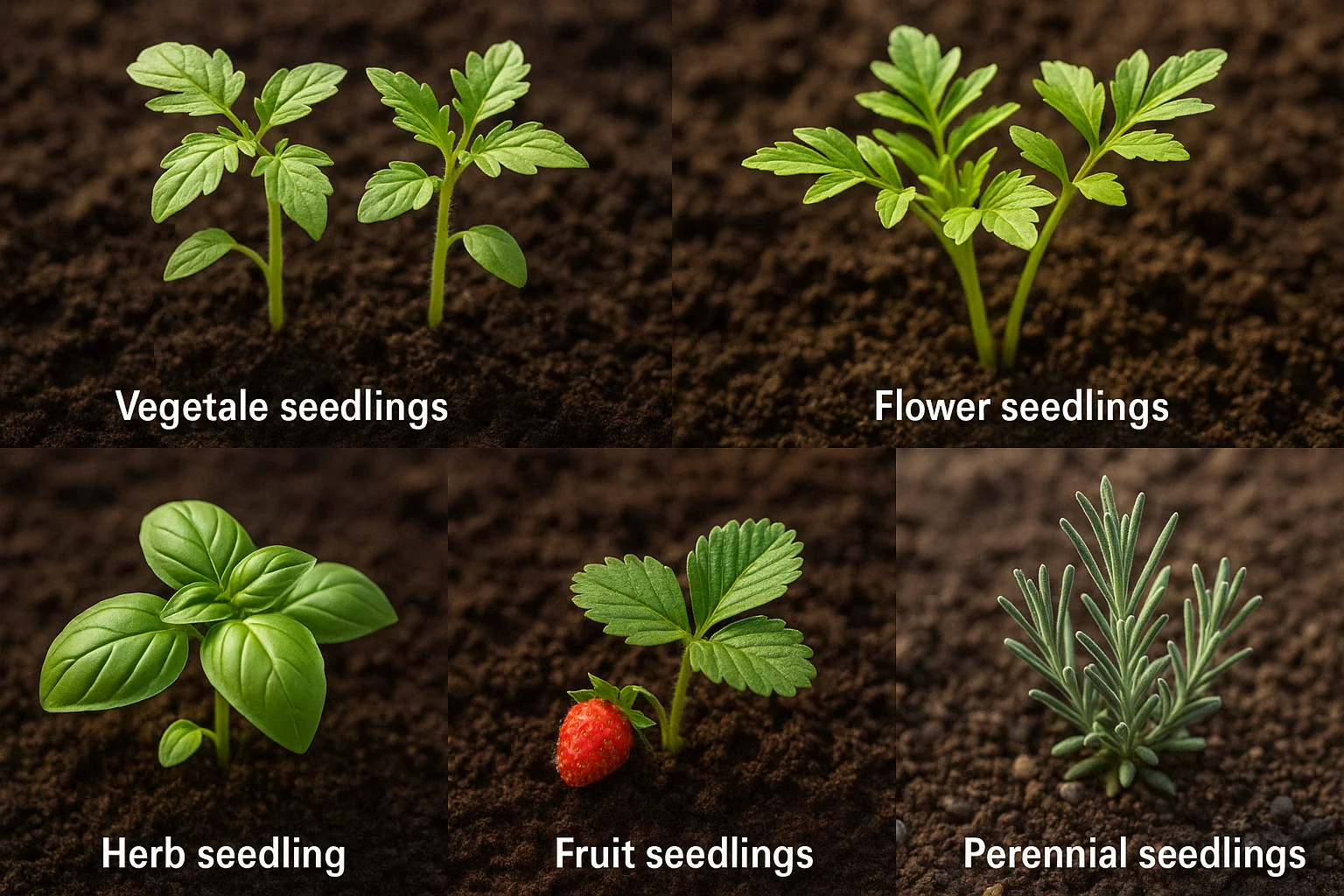
🌿 Vegetable Seedlings 🌿
Vegetable seedlings, such as tomatoes or peppers, need rich, well-draining soil and consistent moisture. They thrive in full sunlight but require protection from extreme temperatures. Harden them off gradually by exposing them to outdoor conditions to avoid transplant shock. Use organic compost or a balanced fertilizer for optimal growth.
🌼 Flower Seedlings 🌼
Flower seedlings like marigolds or sunflowers need plenty of sunlight and well-drained soil. They are sensitive to overwatering, so it’s essential to let the soil dry slightly between waterings. Start them indoors if necessary, but once they’re ready for outdoor planting, ensure they get enough space to grow tall and strong.
🌿 Herb Seedlings 🌿
Herbs like basil, mint, and thyme prefer slightly cooler temperatures and more moisture retention in their soil. They grow well in containers but require good drainage to avoid root rot. Regular pruning encourages bushier growth and prevents them from becoming leggy.
🍓 Fruit Seedlings 🍓
Fruit seedlings, such as strawberries or blueberries, often require well-drained, acidic soil. These seedlings need ample space to spread out, so be mindful of the spacing when planting. Mulching helps retain moisture and keeps the roots cool during hot weather.
🌼 Perennial Seedlings 🌼
Perennials like lavender or echinacea may take a bit longer to establish, but once they do, they require less maintenance. Plant them in well-prepared soil and ensure they have excellent drainage. Water them generously in the first growing season to establish strong roots.
By understanding the specific needs of each seedling type, you can ensure they thrive in their new environment. Whether you’re growing vegetables, flowers, herbs, or fruits, attention to detail and consistent care will lead to vibrant, healthy plants. 🌻
🌿 Common Moisture Control Mistakes and How to Avoid Them 🌿
Proper moisture control is essential for healthy plant growth, but many gardeners make common mistakes that can negatively impact their plants. Here are the most frequent errors and practical tips to avoid them:
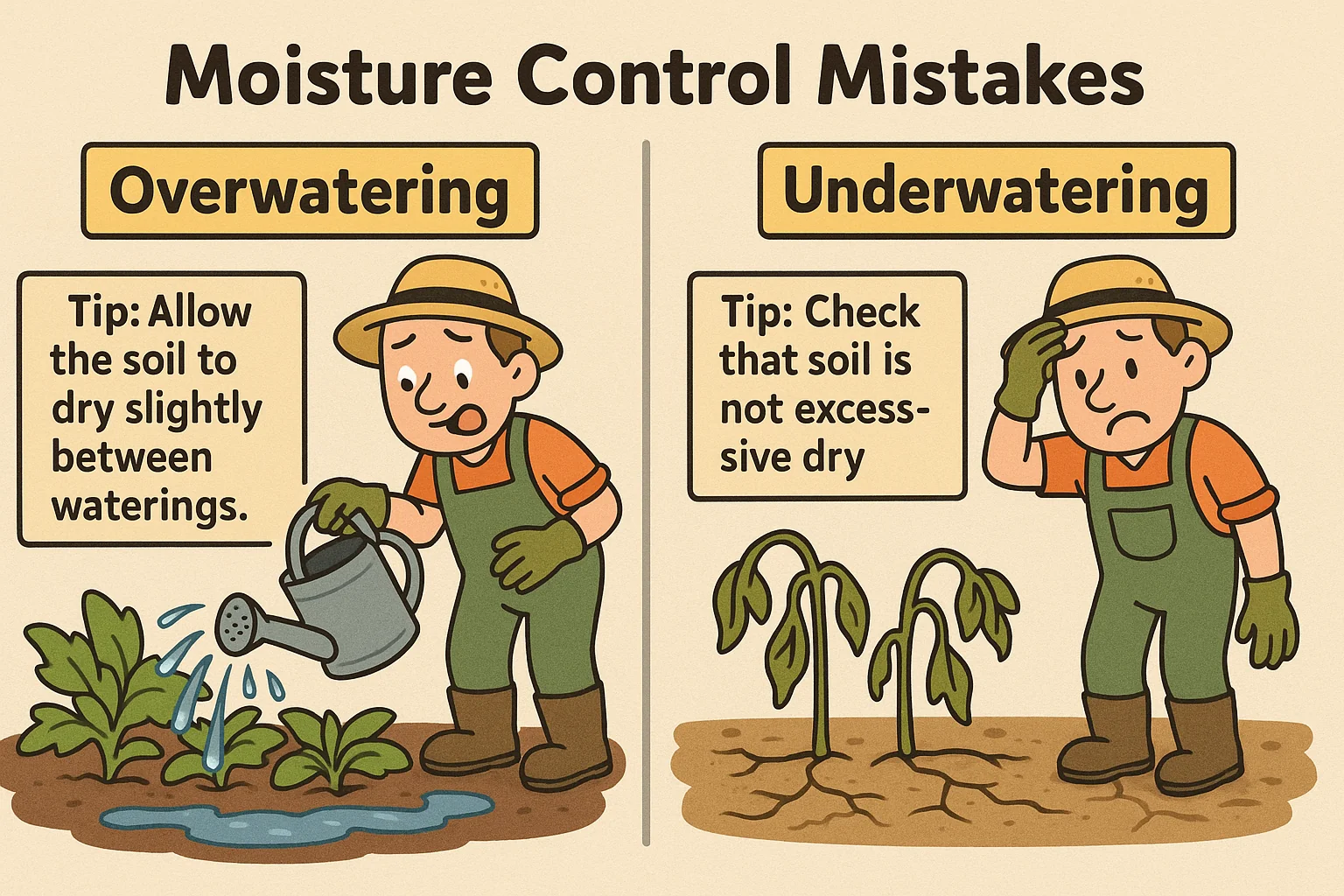
🚫 Overwatering 🚫
Overwatering is one of the most common mistakes, leading to root rot and fungal issues. To avoid this, always check the soil moisture before watering. Use a moisture meter or simply stick your finger into the soil—if it feels damp a couple of inches down, hold off on watering.
💧 Underwatering 💧
While overwatering is dangerous, underwatering can also stress plants. Make sure your plants receive enough water, especially during hot weather. Deep watering encourages roots to grow deeper, which helps the plant withstand dry spells.
🌞 Watering at the Wrong Time 🌞
Watering during the hottest part of the day causes rapid evaporation and leaves plants vulnerable to heat stress. The best time to water is early in the morning or late in the evening when temperatures are cooler.
🌱 Lack of Drainage 🌱
Poor drainage traps excess water in the soil, depriving roots of oxygen and leading to root rot. Always ensure that pots or garden beds have proper drainage holes. If planting in containers, use a well-draining potting mix.
🌦️ Ignoring Environmental Factors 🌦️
Humidity, temperature, and soil type all affect moisture levels. Be aware of your local climate and adjust your watering habits accordingly. For example, in humid areas, you might need to water less frequently than in dry climates.
🌊 Watering Too Shallow 🌊
Shallow watering encourages weak, shallow roots. Water deeply, allowing the moisture to penetrate the root zone. This helps plants grow stronger, more resilient roots and encourages better overall health.
By avoiding these common mistakes and following the right moisture control practices, you can ensure your plants thrive, even in challenging conditions. 🌻
🌱 Final Thoughts 🌱
Mastering moisture control for seedlings is essential for ensuring healthy growth and strong roots. By understanding the unique watering needs of your seedlings, using the right tools, and adjusting your routine based on their specific requirements, you can set your plants up for success from the very beginning.
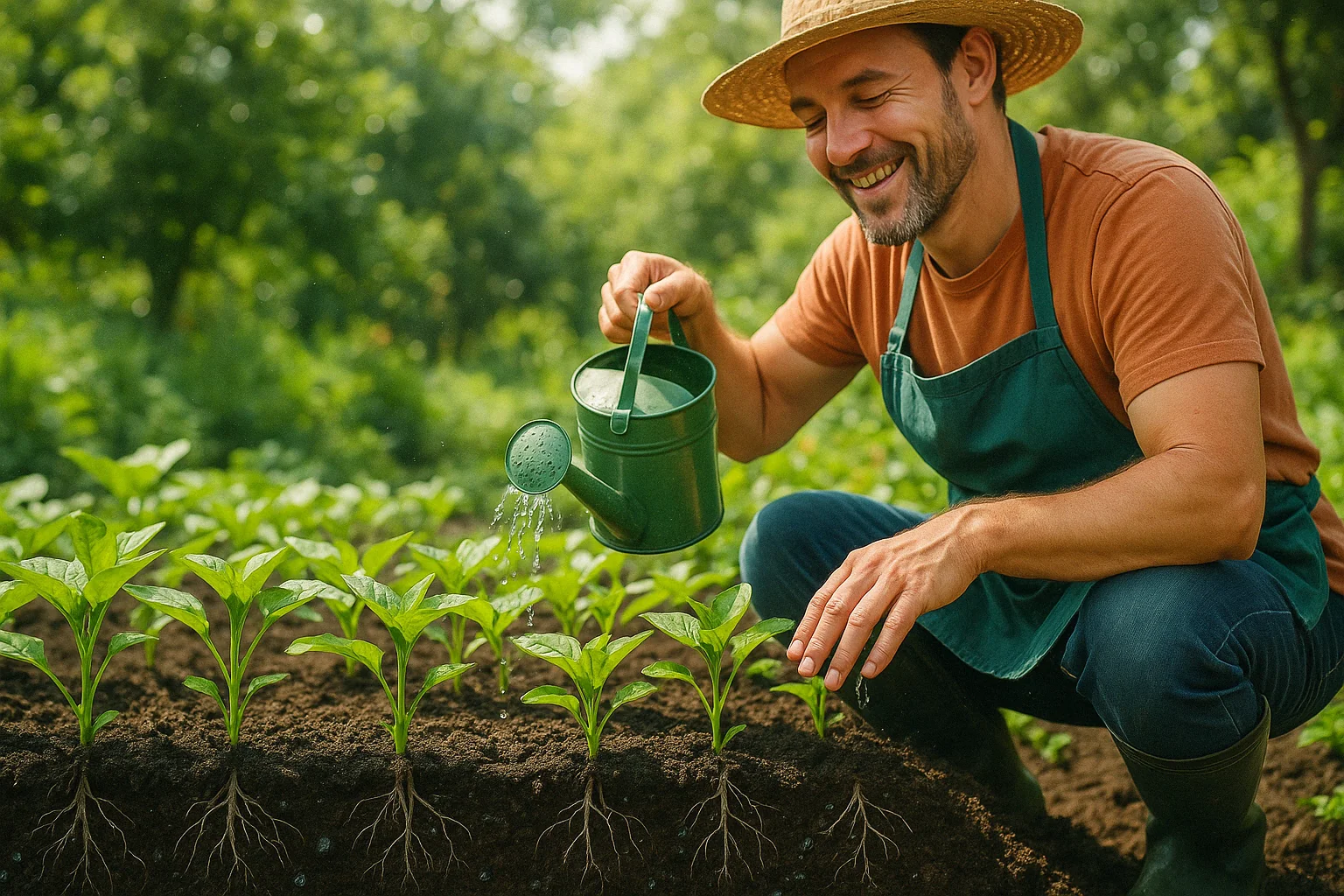
Whether you’re using mulching techniques, humidity domes, or simply learning to spot the signs of overwatering or underwatering, the key to thriving seedlings lies in consistency and care. With these moisture control tips, you’re well on your way to cultivating strong, healthy plants that will flourish as they grow. Keep experimenting, and soon you’ll see the fruits of your efforts in the form of vibrant, thriving seedlings! 🌸
Frequently Asked Questions (FAQ)
Why is moisture control important for seedlings?
Moisture control for seedlings is vital because it ensures the plants receive the right amount of water to support healthy root development and growth. Too much or too little water can harm the seedlings, leading to stunted growth, root rot, or dehydration.
How often should I water my seedlings?
The frequency of watering depends on factors like the type of seedling, soil, and environmental conditions. Typically, seedlings should be watered when the top inch of soil feels dry. However, avoid overwatering, as it can cause root rot. Adjust watering based on the plant’s specific needs.
What is the best way to water seedlings?
To maintain moisture control for seedlings, it’s best to water at the base of the plant, directly on the soil. Use a watering can with a fine nozzle or a mist sprayer to avoid disturbing the young roots. Ensure the soil is evenly moist but not waterlogged.
Can I use a humidity dome for moisture control?
Yes, a humidity dome can help maintain moisture levels, especially for seeds that require a more humid environment for germination. The dome traps moisture, reducing evaporation, and providing a stable growing environment for seedlings. Just be sure to remove it once the seedlings start to grow stronger to avoid excessive humidity.
How can I tell if my seedlings are overwatered or underwatered?
Overwatered seedlings often show signs of yellowing leaves, wilting, or root rot, while underwatered seedlings may have dry, crispy leaves and stunted growth. It’s important to check the moisture level of the soil regularly to avoid both extremes.
Can I use mulch to help control moisture?
Yes, applying a thin layer of mulch around seedlings helps retain moisture, reduce evaporation, and keep the soil temperature stable. Organic mulches like straw or shredded leaves work well, but be sure not to use too much, as it can prevent proper air circulation around the roots.
Are there any tools to help me monitor soil moisture?
Moisture meters are excellent tools for measuring the moisture level in your soil. They provide a more accurate reading than just feeling the soil with your hands, helping you maintain optimal moisture control for seedlings. Alternatively, you can perform a simple test by sticking your finger into the soil to see how moist it feels.
What soil is best for controlling moisture for seedlings?
A well-draining, lightweight potting mix is ideal for seedlings. It retains enough moisture to keep the roots hydrated without becoming waterlogged. A mix designed for seed starting, often containing peat, perlite, and vermiculite, is a good choice for optimal moisture control.
